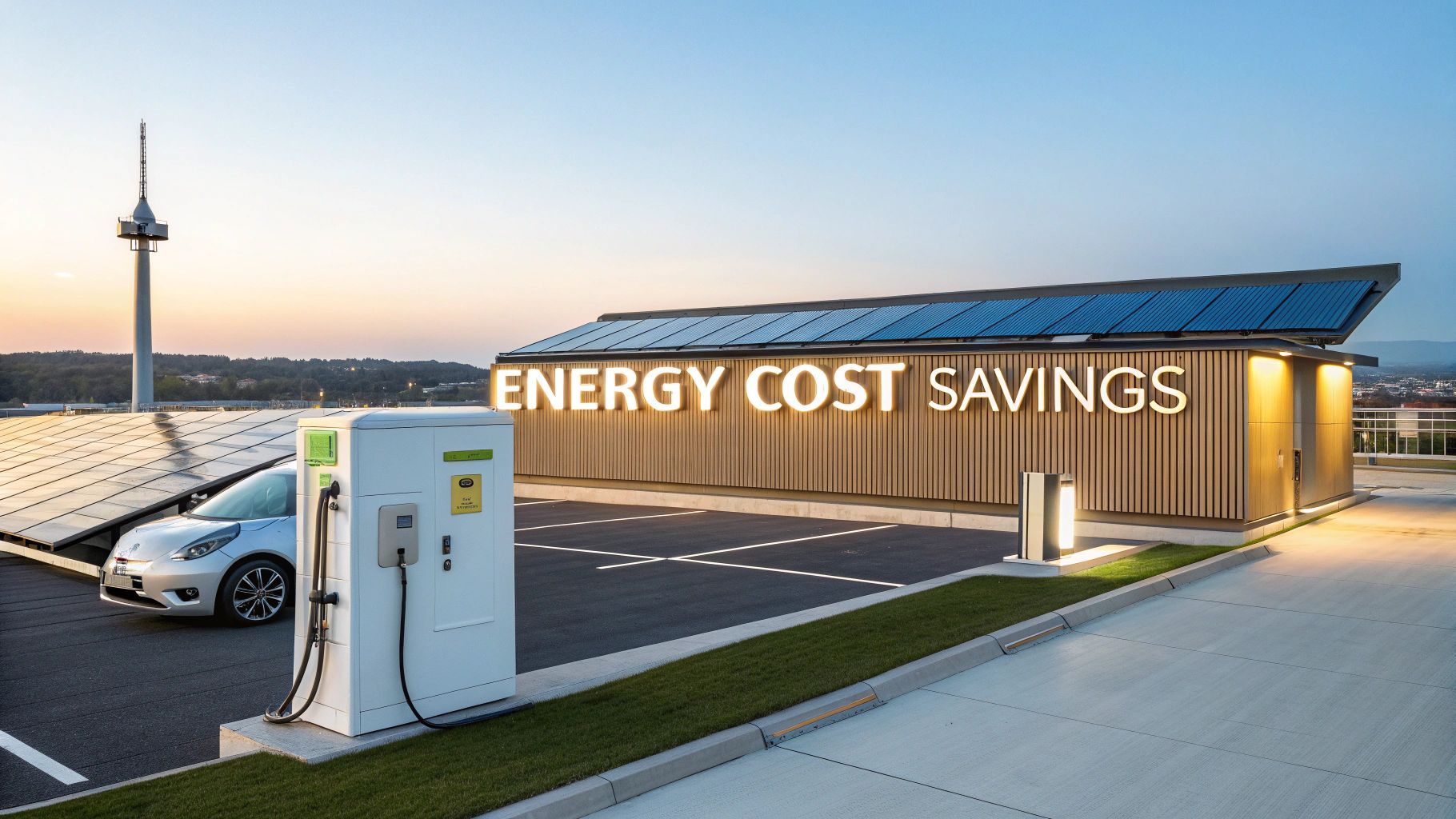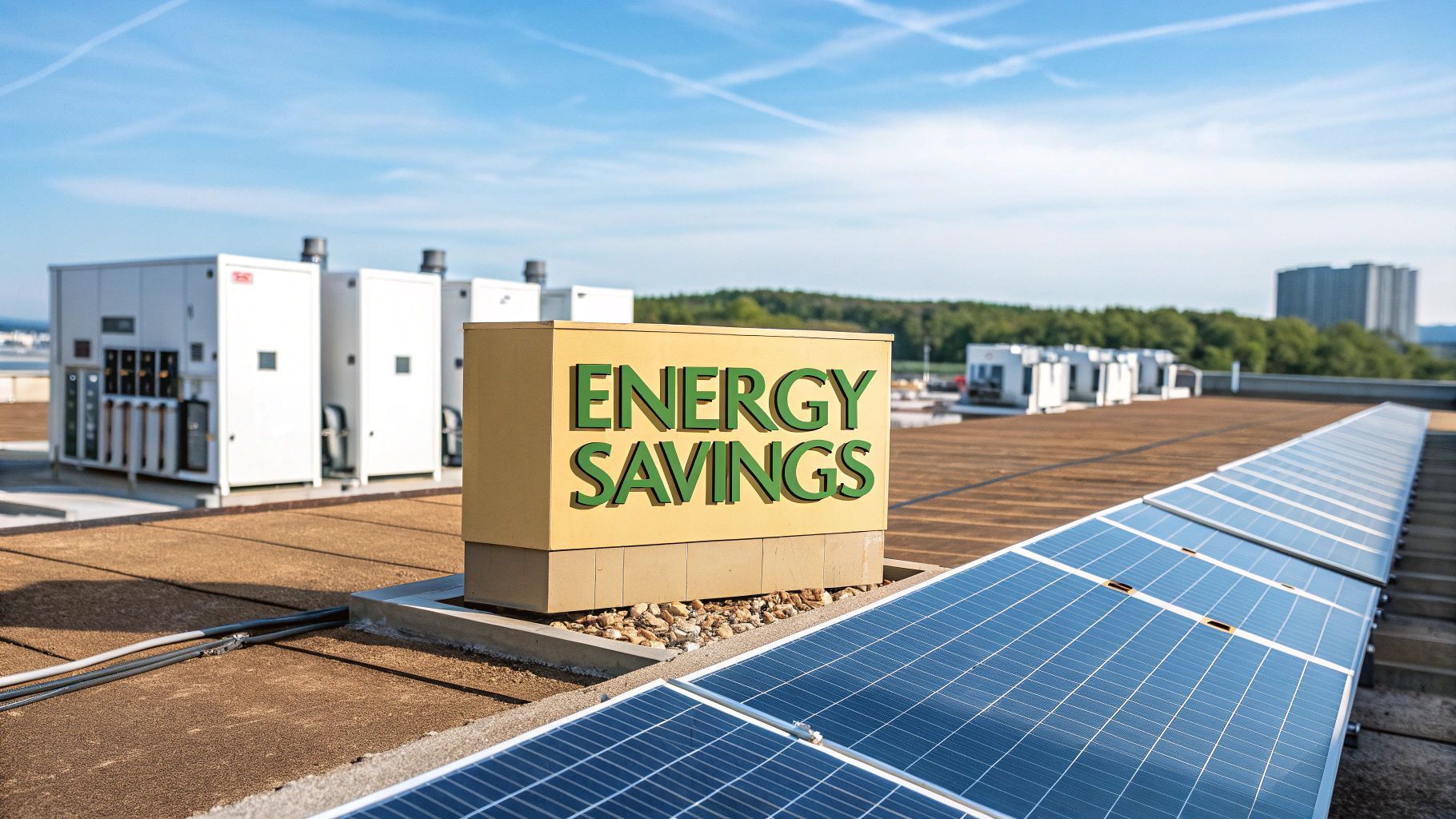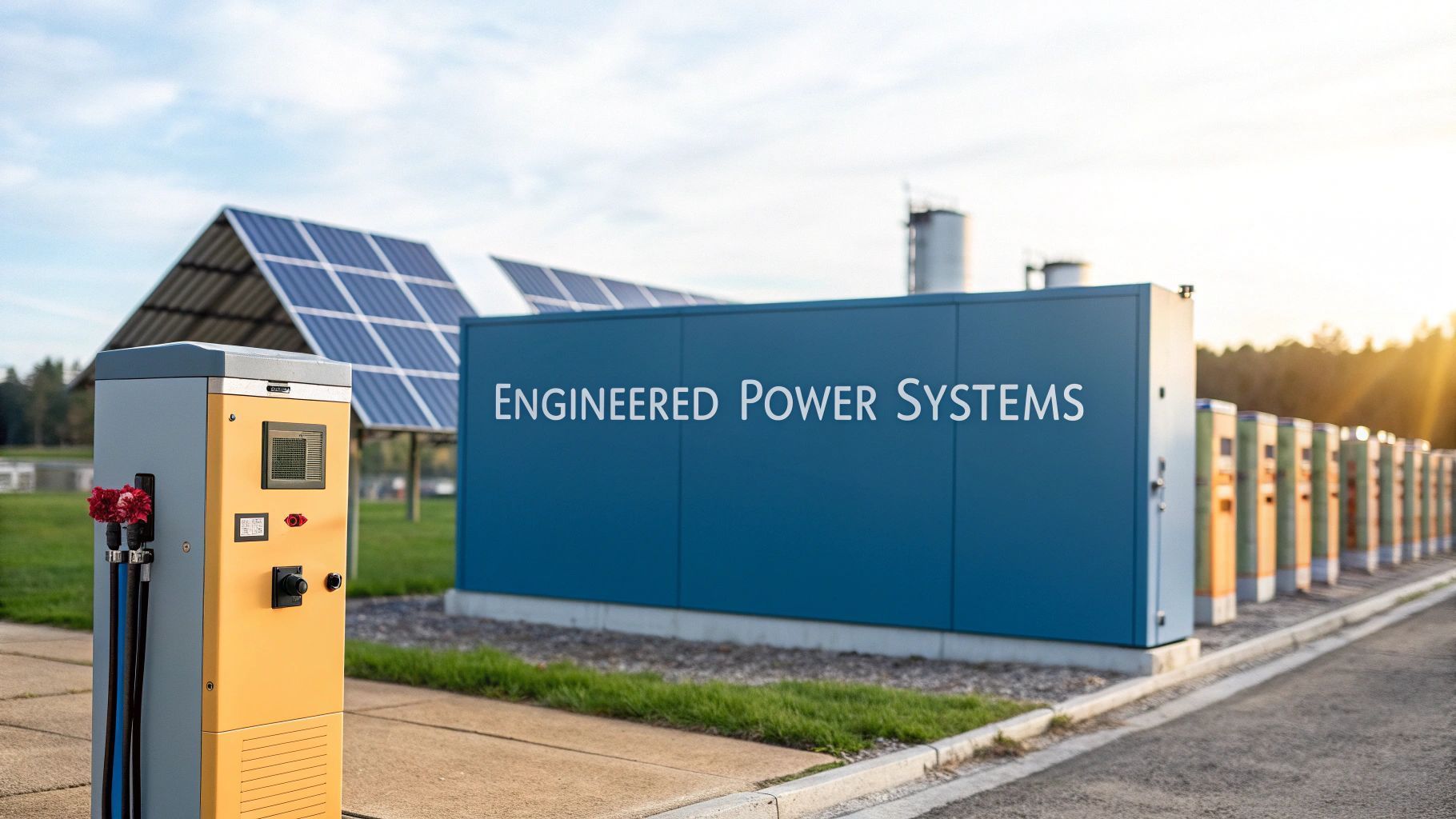Battery Energy Storage Systems: Powering a Green UK Future
Think of a Battery Energy Storage System (BESS) as a financial savings account but for electricity. You store energy when it’s plentiful and cheap then draw on it when demand is high and power is most needed. This technology is fast becoming the backbone of our move to a greener, more resilient energy future.
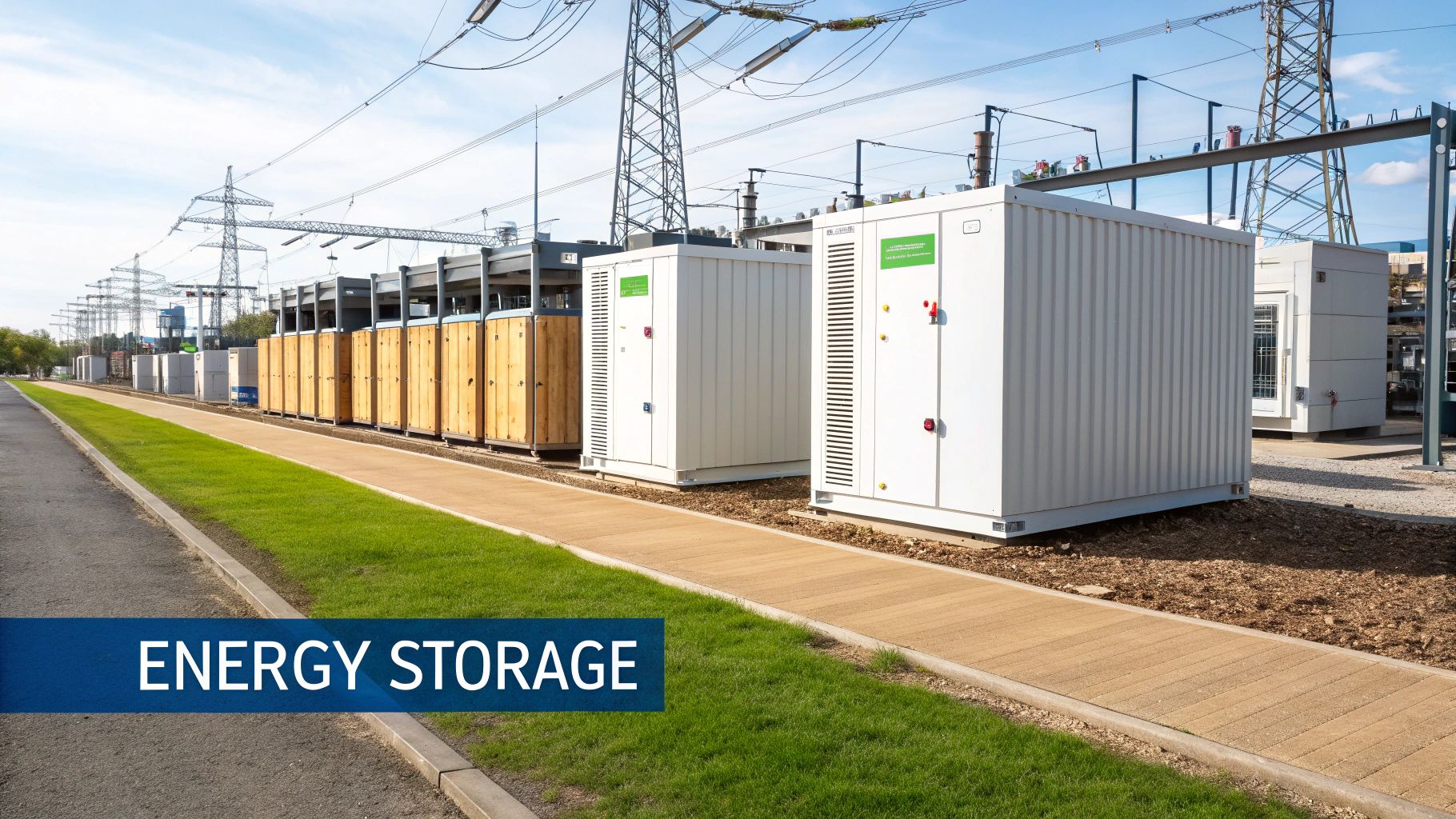
Bridging the Gap in Modern Energy Networks
In simple terms, a battery energy storage system is a technology that captures energy from various sources, converts it from electrical to chemical form and holds onto it for later. When it's needed, the process reverses, sending electricity back to the grid or directly to facilities like rapid EV charging stations. This function is fundamental to the modern UK energy network.
The main job of a BESS is to bridge the critical gap between intermittent renewable generation—like solar and wind—and our constant need for power. It’s the essential buffer that ensures a smooth and reliable supply even when the sun is not shining or the wind is not blowing.
Supporting a Renewable-Powered Grid
The UK's commitment to renewables has made battery energy storage systems a non-negotiable part of our national infrastructure. Since 2020 , the country’s operational battery storage capacity has exploded, growing by a massive 509% from just 1,128 MW to an expected 6,872 MW . You can dive deeper into the UK battery market stats over on RenewableUK.com. This incredible growth shows just how much we need flexible energy solutions to back up green power.
This expansion is what enables a stable energy network, serving a few key functions:
- Grid-Scale Batteries: These large installations soak up excess energy, stopping the grid from overloading when renewable output is high. They then release that power during peak demand, which helps stabilise prices and reduces our reliance on fossil fuel "peaker" plants.
- Distributed Energy: Smaller BESS units, often combined with on-site renewables like solar panels, let businesses and communities generate and store their own power. This creates local, resilient distributed energy networks, often called microgrids.
- EV Charging from Constrained Grid Connections: By storing off-peak energy, a BESS allows rapid EV charging hubs to be built in places where the grid connection is too weak to support them. This sidesteps the need for costly and time-consuming infrastructure upgrades.
At its core, a BESS ensures that the power generated from renewable sources is never wasted. It makes clean energy dependable, dispatchable and available precisely when it is needed most.
Ultimately, these systems are not just about storing power; they are about adding intelligence and flexibility to our entire energy ecosystem. From enabling mobile EV charging solutions to strengthening the national grid, battery energy storage systems are crucial for building a secure, low-carbon future.
Breaking Down the Components of a BESS
To really understand what makes a BESS tick, you have to look under the bonnet. These systems are far more than just a big box of batteries; they are a sophisticated collection of hardware and software, all working in perfect harmony to store and deliver power when it’s needed most. Each part has a very specific and vital job to do.
The infographic below gives a great overview of the fundamental charge-discharge cycle. It shows how the BESS soaks up surplus renewable energy and then releases it back to support the grid when demand is high.
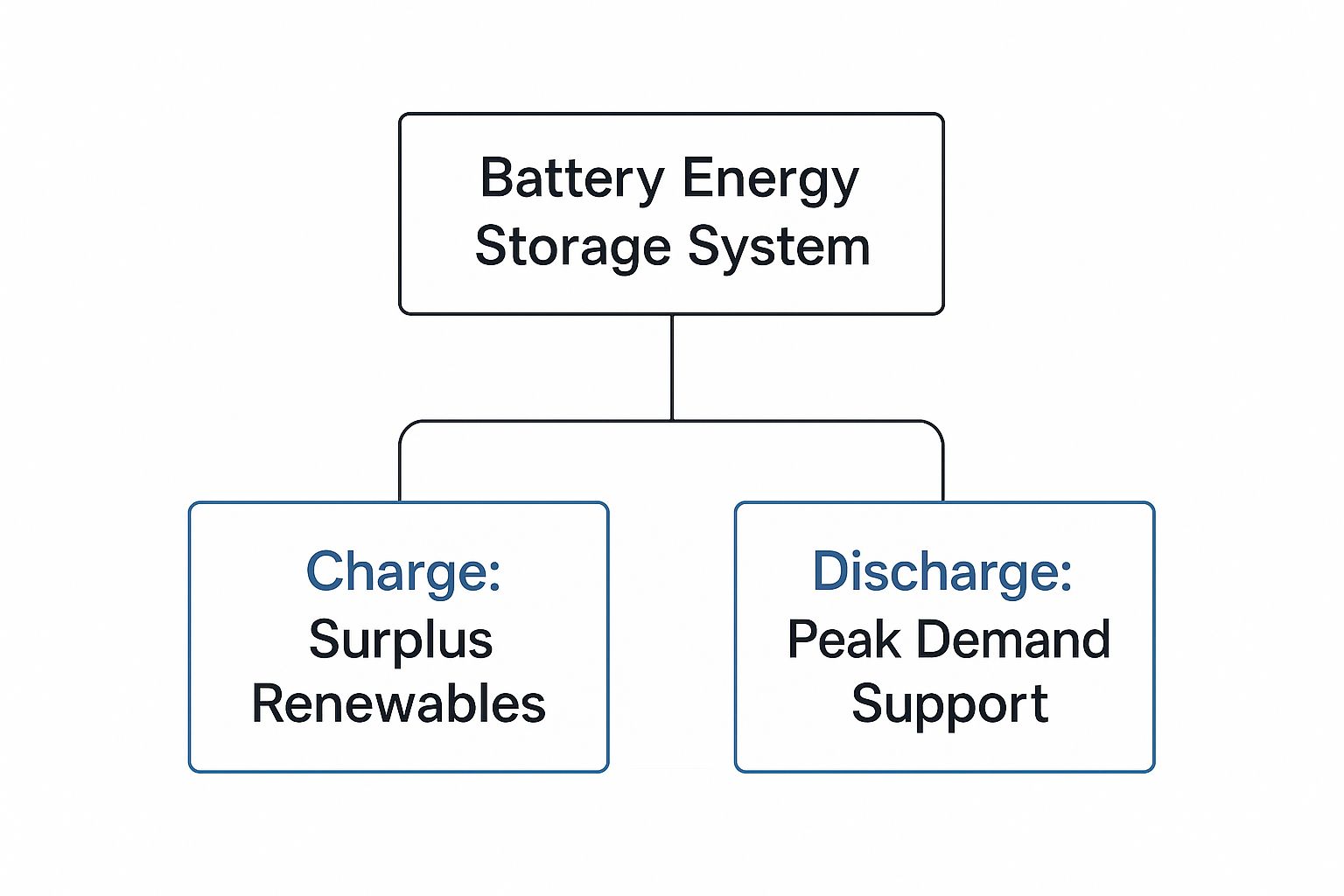
This simple cycle is the core function that makes a BESS so valuable for grid stability and for enabling power-hungry technology like rapid EV charging. Let’s break down the key bits of kit that make it all happen.
To make things clearer, let’s unpack the primary components inside a BESS and what each one does. Think of it as a high-tech team where every player has a crucial role.
Key Components of a Battery Energy Storage System
| Component | Primary Function | Analogy |
|---|---|---|
| The Battery System | The core energy reservoir; stores electrical energy chemically. | The system's fuel tank . Its size determines how much energy can be held. |
| Battery Management System (BMS) | Monitors and protects the individual battery cells. | The system's health monitor or protective brain , ensuring everything runs safely. |
| Power Conversion System (PCS) | Converts electricity between Direct Current (DC) and Alternating Current (AC). | A universal translator allowing the battery to talk to the grid and appliances. |
| Energy Management System (EMS) | The high-level controller that makes strategic decisions on when to charge or discharge. | The system's strategic commander , making smart economic and operational decisions. |
Each of these parts is essential. Without any one of them, the system simply would not work effectively or safely. Now, let’s dive a bit deeper into each role.
The Battery System: The Heart of the Operation
Right at the centre of any BESS is the Battery System itself. You can think of this as the reservoir that actually holds the stored energy. Today, the technology of choice is almost always lithium-ion, which is favoured for its high energy density, excellent efficiency and rapidly falling costs.
But these are not just scaled-up versions of the battery in your phone. They are incredibly robust modules, engineered from the ground up to handle thousands of charge and discharge cycles over many years. These individual modules are arranged in stacks and racks to build up the required voltage and capacity, whether it’s for a small commercial site or a massive grid-scale battery installation.
Battery Management System: The Protective Brain
Constantly watching over every single battery cell is the Battery Management System (BMS) . This is the system’s intelligent brain, laser-focused on ensuring the safety, longevity and efficiency of the batteries. It’s like a diligent health monitor, continuously tracking vital signs for every cell in the pack.
The BMS is absolutely critical for a few key reasons:
- Safety: It keeps a close eye on temperature and voltage to prevent dangerous situations like thermal runaway.
- Performance: It optimises how the batteries charge and discharge to squeeze out the maximum possible lifespan and usable capacity.
- Balancing: It makes sure all the cells are charged and discharged evenly, stopping any single part from wearing out prematurely.
Without a sophisticated BMS, a battery system would be both unsafe and unreliable, with a drastically shorter operational life.
A BESS is a finely balanced ecosystem. The BMS ensures that the powerful battery core operates not just effectively but also safely, protecting the entire investment and ensuring reliable performance day after day.
Power Conversion System: The Universal Translator
Here’s a simple fact: the electricity stored in a battery is Direct Current (DC) but our national grid and pretty much all of our electrical devices run on Alternating Current (AC). This mismatch is where the Power Conversion System (PCS) comes in. The PCS, often just called an inverter, acts as a clever, bidirectional translator.
When the system is charging, the PCS converts AC power from the grid or a renewable source into the DC power the battery needs. When it’s discharging, it does the exact opposite, converting the battery’s DC power back into high-quality AC power that can be fed into the grid or used for things like rapid EV charging . The PCS is the essential gateway that lets the BESS talk to the outside world.
Energy Management System: The Strategic Commander
Finally, we have the Energy Management System (EMS) . This is the strategic commander that tells the whole system what to do and when to do it. While the BMS is obsessed with battery health, the EMS is looking at the bigger picture and making intelligent economic decisions.
The EMS uses advanced software to analyse data like fluctuating electricity prices, grid demand, weather forecasts and the specific needs of a site. Based on all this information, it decides the most profitable times to charge the battery (when energy is cheap) or discharge it (when it's expensive or most needed).
For applications like EV charging from constrained grid connections , the EMS is the key to unlocking "peak shaving"—charging the battery slowly during off-peak hours and then unleashing that energy quickly to meet the demands of multiple EV drivers at once. This smart control layer is what truly unlocks the full economic and operational value of battery energy storage systems .
Powering the Grid with Large-Scale Batteries
Think of large-scale battery energy storage systems as enormous energy reservoirs for the national grid. They are a vital tool in the delicate balancing act of matching electricity supply with demand—a challenge that has become much trickier with the rise of intermittent renewable energy sources across Britain.
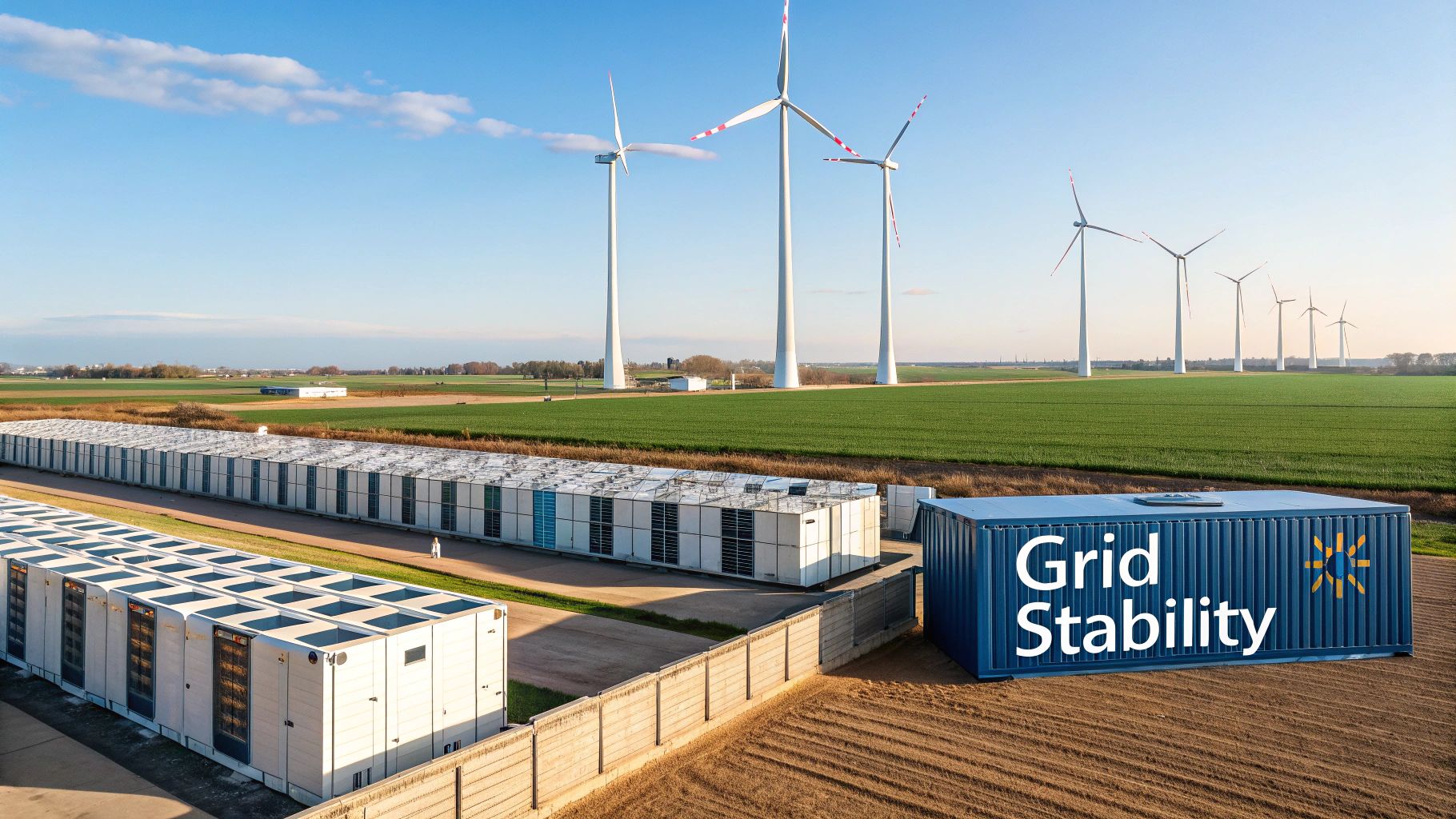
Picture a brilliantly sunny and windy Sunday afternoon. Solar farms and wind turbines are churning out huge amounts of electricity, far more than anyone needs at that moment. Without storage, all that clean energy would either go to waste or, worse, overload the grid, forcing operators to switch off the renewables.
This is exactly where grid-scale batteries come in. These giant installations soak up the surplus power, storing it safely away. Later, during the weekday evening peak when millions of us get home and flick on our appliances, that stored energy is injected back into the grid. This simple action helps keep the lights on, reduces our reliance on expensive fossil fuel power plants and brings a much-needed stability to electricity prices.
The Financial and Technical Benefits for Grid Stability
The business case for battery energy storage systems is incredibly strong. They excel at energy arbitrage—essentially, buying low and selling high. We saw a perfect example of this in Great Britain during a June heatwave, when operators earned revenues hitting £76,000 per megawatt per year , a 20% jump from the previous month.
This impressive figure was driven by the system's ability to charge during 66 hours of negative pricing (when renewables flooded the market) and then discharge during sharp price spikes.
But it’s about more than just profits. These systems provide essential services that keep our power supply secure. One of the most important is frequency response . The UK grid has to be kept at a precise frequency of 50 Hertz (Hz) . Any deviation, even a small one, can lead to widespread blackouts.
Battery systems can react in milliseconds to fluctuations in grid frequency. By instantly absorbing or injecting power, they act as a high-speed shock absorber, ensuring the grid remains stable and reliable for everyone.
This rapid-fire capability is something traditional power plants just cannot replicate, making batteries an essential part of a modern, resilient grid.
Building a Decarbonised and Resilient Network
The true potential of these systems is unlocked when they are paired with on-site renewables. A solar farm combined with a large-scale battery becomes a fully dispatchable power plant, able to deliver clean energy on demand, day or night. This powerful partnership is the bedrock of a decarbonised energy network.
This combination of technologies creates what we call distributed energy , where power is generated and stored much closer to where it is actually used. This setup has several key advantages:
- Reduced Transmission Losses: Less energy is wasted when it does not have to travel hundreds of miles across the country.
- Enhanced Local Resilience: Local energy networks can keep running even if there are problems on the main national grid.
- Improved Grid Efficiency: It eases congestion on major power lines, supporting a more balanced and efficient flow of electricity.
For these large-scale systems, staying online is critical. That’s why advanced utility maintenance methods like drone power line inspection are becoming essential to ensure continuous, reliable power delivery.
Ultimately, integrating grid-scale batteries and renewables is not just about adding new kit to the grid. It’s about making the entire system smarter, more robust and ready for a low-carbon future. To see this in action, you can learn more about how ZPN's energy solutions support grid stability and resilience.
How Battery Storage Unlocks Rapid EV Charging
The nationwide shift to electric vehicles faces one major roadblock: the charging infrastructure. Dropping a bank of rapid and ultra-rapid chargers onto a site places an immense strain on the local electricity grid. For many otherwise perfect locations, like retail parks or rural service stations, the grid connection simply is not strong enough to handle the sudden, massive power draw needed.
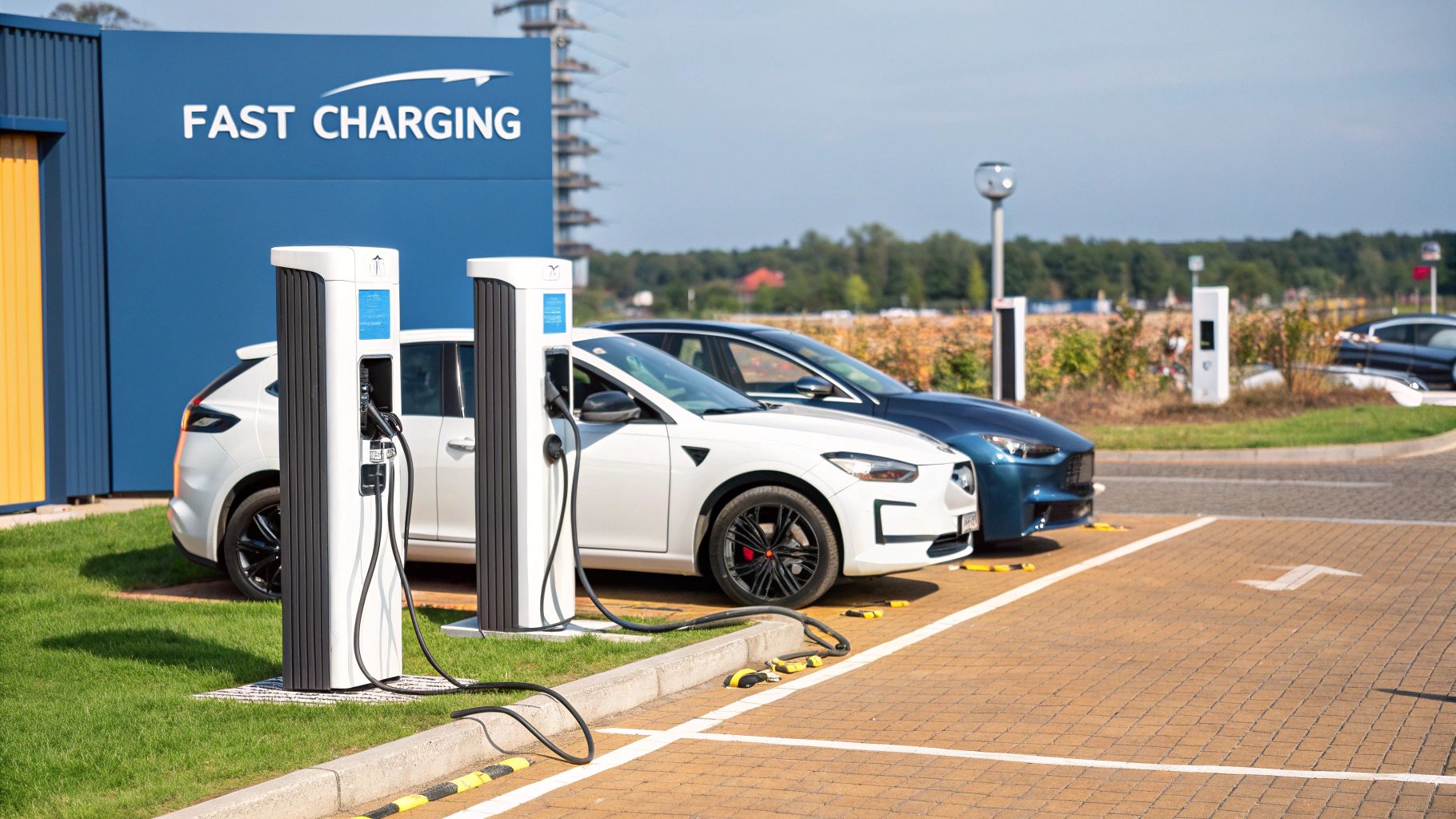
This is where a battery energy storage system comes in, acting as the essential piece of the puzzle. A BESS is a powerful buffer between the grid and the charger, neatly solving the problem of EV charging from constrained grid connections . Instead of getting bogged down in slow and prohibitively expensive grid upgrades, a BESS can be installed to manage the power flow intelligently.
It works by charging up slowly during off-peak hours, when grid demand is low and electricity is cheap. The battery then holds that energy in reserve, ready to unleash it in a powerful burst to deliver rapid EV charging to multiple EVs at once during peak times. This completely bypasses the grid's limitations, making it possible to deploy high-speed charging hubs almost anywhere.
The Power of Peak Shaving for EV Charging
This clever process of storing cheap energy to use during expensive peak demand is known as peak shaving . For charge point operators, it’s a genuine game-changer, making their business model far more profitable and sustainable. Without a battery, they would be forced to pull huge amounts of power from the grid at the most expensive times of the day, sending their operational costs sky-high.
A battery energy storage system flips this scenario on its head. By drawing power overnight or during other low-cost periods, the BESS dramatically slashes the operator's electricity bill. This creates a much more stable financial foundation for the charging network, which in turn encourages wider and faster deployment.
This synergy between EV charging and batteries is crucial for a few key reasons:
- Avoids Grid Upgrades: It gets rid of the need for costly and time-consuming infrastructure work, which can often hold up projects for months or even years.
- Reduces Operational Costs: It lowers electricity bills by shifting energy use to off-peak times, making charging hubs more financially viable.
- Supports Grid Stability: It stops the local grid from being overloaded by the sudden, intense demand of multiple rapid chargers firing up at once.
By integrating these systems, operators can deliver the fast, reliable service that EV drivers expect without putting undue stress on our national energy infrastructure. You can explore a deeper dive into the world of battery-backed EV charging solutions to see how this technology works in practice.
By acting as an intermediary, a BESS effectively decouples the charging speed from the grid connection's capacity. It allows for the installation of 150kW or 350kW ultra-rapid chargers even in locations with a grid connection that could barely support a single slow charger.
Unleashing Mobile EV Charging Solutions
The flexibility of battery energy storage systems also powers the growing field of mobile EV charging . These are essentially large batteries on wheels, capable of delivering a rapid charge wherever it is needed most. This technology is opening up a world of new possibilities for keeping electric vehicles on the move.
Think of a fleet depot that needs to charge dozens of electric vans overnight but does not have the grid capacity for permanent chargers at every bay. A mobile unit can be brought in to top up the fleet efficiently, with no need for permanent installation.
Likewise, these mobile power banks are perfect for providing temporary charging at events and festivals, or even for roadside assistance when an EV runs out of juice. They represent the ultimate in flexible distributed energy , bringing the power directly to the vehicle. It just goes to show that batteries do not just support fixed infrastructure; they create entirely new and adaptable ways to service the electric vehicle market.
The Rise of Distributed Energy and Microgrids
While massive grid-scale projects grab headlines, battery energy storage systems are quietly driving a local energy revolution. This change is fuelling the rise of distributed energy , a concept where electricity is generated and stored much closer to where it’s actually used. It’s a complete rethink of the old, centralised grid, moving us towards a network of smaller, smarter and more resilient local systems.
At the very heart of this movement are microgrids. Think of a microgrid as a self-contained energy island that can operate completely independently from the main national grid. Businesses, industrial parks and even entire communities are now creating these localised power networks by combining on-site renewables, like solar panels, with a BESS.
This setup delivers incredible resilience. If there’s a power cut on the main grid, a microgrid can just disconnect and carry on powering its essential operations with its stored energy. For places like hospitals or data centres, where a constant power supply is absolutely non-negotiable, this capability is a game-changer.
Taking Control of Commercial Energy Costs
For commercial sites, the financial upside of a distributed energy approach is just as powerful. Energy bills can be a huge overhead, particularly with electricity prices that rocket during peak demand. A BESS working alongside on-site renewables gives a business the power to generate and store its own low-cost, green electricity.
This stored power can then be deployed to run operations during the most expensive peak hours—a tactic known as peak shaving. Instead of paying premium rates to the utility, the business simply draws from its own battery. This gives them direct control over their energy costs, shielding them from volatile market prices and making a real dent in their operational spending.
The combination of on-site generation and storage effectively creates a private energy supply. It transforms a business from a passive consumer into an active participant in its own energy management, boosting both its financial bottom line and its carbon reduction credentials.
This level of control is a key reason for commercial adoption, empowering businesses to fine-tune their energy usage for maximum efficiency and savings.
The Democratisation of Home Energy
But this trend is not just for businesses. Homeowners across the UK are also getting in on the action, pairing rooftop solar panels with home battery systems. This consumer-led shift is often called the democratisation of energy because it puts power—quite literally—back into the hands of individuals.
And this shift is happening fast. The UK has seen a huge surge in small-scale battery storage installations. In one recent May, newly certified installations hit nearly 3,400 —that’s a 112% increase on the previous year and the highest monthly figure on record. You can read more about this boom over at PV Magazine.
This boom in home storage allows households to get the most out of their self-generated solar power. Instead of sending surplus energy back to the grid for a pittance, they can store it for use in the evening. This cuts their reliance on grid electricity and bolsters their energy security. By becoming more self-sufficient, these homes are the building blocks of a more decentralised and robust national energy network. To see how these systems fit into the bigger picture, explore our guide on maximising the efficiency of microgrids.
As we look ahead, the story of battery energy storage systems is not just about gradual improvement; it's about a complete re-imagining of their role. The technology is quickly moving beyond simply supporting the grid to becoming an active, intelligent partner within it. This shift is being powered by new materials, smarter software and forward-thinking ideas that are changing our relationship with energy.
While lithium-ion batteries have been the undisputed champion for years, their reign is not set in stone. Engineers and researchers are pushing hard to develop new battery chemistries that promise to be cheaper, safer and more sustainable. This next wave of innovation is essential if we are going to meet the massive global appetite for energy storage.
Emerging Battery Chemistries
The hunt for alternatives to lithium-ion is all about finding batteries that are just as effective but are built from more abundant and ethically sourced materials. A couple of key contenders are already making a name for themselves:
- Sodium-ion batteries: These operate in a remarkably similar way to their lithium-ion cousins but they use sodium—an element that's thousands of times more common and much cheaper to get hold of. They might have a slightly lower energy density for now but for stationary, grid-scale batteries where cost matters more than a compact size, they are a perfect fit.
- Solid-state batteries: This technology represents a huge leap in both safety and performance. By swapping the liquid electrolyte in conventional batteries for a solid material, they practically eliminate the risk of fire. They also promise much faster charging times and a longer lifespan, making them an incredibly compelling option for the next generation of EVs and grid projects.
These new chemistries are not just minor tweaks; they signal a fundamental change in how we build and use battery energy storage systems .
The future of battery storage is not about finding one single 'perfect' battery. It’s about building a diverse portfolio of technologies, where different chemistries are used for the jobs they do best—from cheap, rugged grid storage to high-performance mobile power.
The Role of Artificial Intelligence
It’s not just the hardware that’s getting an upgrade. The intelligence controlling these systems is becoming far more sophisticated too. Artificial intelligence (AI) and machine learning algorithms are being woven into Energy Management Systems to boost performance in ways we could only have dreamed of before. These smart systems can crunch massive amounts of data in real-time.
AI will make predictive grid management a reality, anticipating dips in renewable generation or spikes in demand with uncanny accuracy. This lets a BESS get ready for grid events before they even happen, leading to a much more stable and efficient network. In the world of energy trading, AI can execute buy and sell decisions in milliseconds, taking advantage of tiny price shifts to maximise revenue.
Vehicle-to-Grid: A Distributed Energy Vision
Perhaps the most exciting shift on the horizon is Vehicle-to-Grid (V2G) technology. This idea transforms electric vehicles from simple energy consumers into active players in a huge, distributed energy network. When an EV is plugged in, a V2G system allows it to not only charge up but also push stored energy from its battery back to the grid during peak hours.
Just imagine millions of EVs parked at homes and offices, all acting as one gigantic, coordinated battery. This network could offer immense support to the grid, smoothing out demand and strengthening resilience without having to build a single new power station. This is the ultimate vision of a flexible, fully decarbonised energy system, where every connected device has a part to play.
Of course. Here is the rewritten section, designed to match the expert, human tone of the provided examples.
Got Questions? We've Got Answers
To help clear things up, here are a few straightforward answers to the questions we hear most often about battery energy storage and what it can do in the real world.
How Long Do These Battery Systems Actually Last?
This really comes down to the battery's chemistry, how it is used day-to-day and the conditions it operates in. But as a good rule of thumb, most modern grid-scale lithium-ion batteries are built to last between 10 and 20 years .
You will often hear their lifespan measured in charge-discharge cycles, and they are good for thousands of them. The real secret to a long life, though, is a sophisticated Battery Management System (BMS). It acts as the brain, protecting the battery from stress by making sure it never overcharges or drains too deeply, which is key to maximising its operational life.
Can a BESS Keep My Business Running During a Power Cut?
Absolutely. Providing backup power is one of the biggest benefits, especially when a BESS is part of a microgrid that includes on-site generation like solar panels. It is a cornerstone of what we call distributed energy solutions.
When the main grid fails, the system shifts into 'island mode'. It simply disconnects from the national network and draws on its stored energy to power your critical operations. This ensures business continuity for any facility where an uninterrupted power supply is non-negotiable.
A BESS offers more than just cost savings; it delivers energy resilience. By creating a buffer against grid instability, it ensures that your operations can continue seamlessly even when the external power supply fails.
This capability is a game-changer for commercial sites where even a brief outage can lead to serious financial losses or bring operations to a grinding halt.
Are These Battery Systems Just for Solar and Wind?
Not at all. While battery energy storage systems are a perfect match for renewables—smoothing out their naturally variable output—their uses go much further. They are also essential for stabilising the entire grid, providing services like frequency regulation and helping manage demand during peak times on the national network.
Their versatility is what makes them so valuable. Some of the key applications include:
- Rapid EV Charging: They make high-speed charging hubs possible in places where the grid connection is weak, saving you the time and expense of major grid upgrades.
- Mobile EV Charging: They are the power source behind mobile charging units that can be deployed wherever and whenever they’re needed.
- Energy Arbitrage: You can store cheap off-peak electricity from any source and sell it back to the grid when prices are high, turning your energy storage into a revenue stream.
This multi-faceted capability makes them a cornerstone of modern, flexible energy networks. They support everything from large-scale grid stability right down to local EV infrastructure, unlocking new possibilities by managing power flow intelligently across the entire energy sector.
At ZPN Energy , we specialise in designing and deploying advanced battery energy storage systems that empower businesses to take control of their energy future. From unlocking rapid EV charging to building resilient microgrids, our solutions are engineered for performance and reliability. Discover how our technology can work for you at zpnenergy.com.


